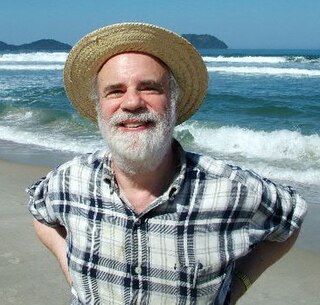Related Research Articles
In the philosophy of language, a proper name – examples include a name of a specific person or place – is a name which ordinarily is taken to uniquely identify its referent in the world. As such it presents particular challenges for theories of meaning, and it has become a central problem in analytic philosophy. The common-sense view was originally formulated by John Stuart Mill in A System of Logic (1843), where he defines it as "a word that answers the purpose of showing what thing it is that we are talking about but not of telling anything about it". This view was criticized when philosophers applied principles of formal logic to linguistic propositions. Gottlob Frege pointed out that proper names may apply to imaginary or nonexistent entities, without becoming meaningless, and he showed that sometimes more than one proper name may identify the same entity without having the same sense, so that the phrase "Homer believed the morning star was the evening star" could be meaningful and not tautological in spite of the fact that the morning star and the evening star identifies the same referent. This example became known as Frege's puzzle and is a central issue in the theory of proper names.

Saul Aaron Kripke was an American analytic philosopher and logician. He was Distinguished Professor of Philosophy at the Graduate Center of the City University of New York and emeritus professor at Princeton University. Kripke is considered one of the most important philosophers of the latter half of the 20th century. Since the 1960s, he has been a central figure in a number of fields related to mathematical and modal logic, philosophy of language and mathematics, metaphysics, epistemology, and recursion theory.

Hume's fork, in epistemology, is a tenet elaborating upon British empiricist philosopher David Hume's emphatic, 1730s division between "relations of ideas" and "matters of fact." As phrased in Immanuel Kant's 1780s characterization of Hume's thesis, and furthered in the 1930s by the logical empiricists, Hume's fork asserts that all statements are exclusively either "analytic a priori" or "synthetic a posteriori," which, respectively, are universally true by mere definition or, however apparently probable, are unknowable without exact experience.
Logical possibility refers to a logical proposition that cannot be disproved, using the axioms and rules of a given system of logic. The logical possibility of a proposition will depend upon the system of logic being considered, rather than on the violation of any single rule. Some systems of logic restrict inferences from inconsistent propositions or even allow for true contradictions. Other logical systems have more than two truth-values instead of a binary of such values. Some assume the system in question is classical propositional logic. Similarly, the criterion for logical possibility is often based on whether or not a proposition is contradictory and as such, is often thought of as the broadest type of possibility.
In modal logic and the philosophy of language, a term is said to be a rigid designator or absolute substantial term when it designates the same thing in all possible worlds in which that thing exists. A designator is persistently rigid if it also designates nothing in all other possible worlds. A designator is obstinately rigid if it designates the same thing in every possible world, period, whether or not that thing exists in that world. Rigid designators are contrasted with connotative terms, non-rigid or flaccid designators, which may designate different things in different possible worlds.
A causal theory of reference or historical chain theory of reference is a theory of how terms acquire specific referents based on evidence. Such theories have been used to describe many referring terms, particularly logical terms, proper names, and natural kind terms. In the case of names, for example, a causal theory of reference typically involves the following claims:
In philosophy, metaphysical necessity, sometimes called broad logical necessity, is one of many different kinds of necessity, which sits between logical necessity and nomological necessity, in the sense that logical necessity entails metaphysical necessity, but not vice versa, and metaphysical necessity entails physical necessity, but not vice versa. A proposition is said to be necessary if it could not have failed to be the case. Nomological necessity is necessity according to the laws of physics and logical necessity is necessity according to the laws of logic, while metaphysical necessities are necessary in the sense that the world could not possibly have been otherwise. What facts are metaphysically necessary, and on what basis we might view certain facts as metaphysically but not logically necessary are subjects of substantial discussion in contemporary philosophy.
A possible world is a complete and consistent way the world is or could have been. Possible worlds are widely used as a formal device in logic, philosophy, and linguistics in order to provide a semantics for intensional and modal logic. Their metaphysical status has been a subject of controversy in philosophy, with modal realists such as David Lewis arguing that they are literally existing alternate realities, and others such as Robert Stalnaker arguing that they are not.

In Greek mythology, Hesperus is the Evening Star, the planet Venus in the evening. A son of the dawn goddess Eos, he is the half-brother of her other son, Phosphorus. Hesperus' Roman equivalent is Vesper. By one account, Hesperus' father was Cephalus, a mortal, while Phosphorus was the star god Astraios. Other sources, however, state that Hesperus was the brother of Atlas, and thus the son of Iapetus.
A referential theory of meaning is a theory of language that claims that the meaning of a word or expression lies in what it points out in the world. Ex, The word tree may have an exterior meaning from the one always intended, that is, tree can be translated into different form of meaning .The object denoted by a word is called its referent. Criticisms of this position are often associated with Ludwig Wittgenstein.
In the philosophy of language, the descriptivist theory of proper names is the view that the meaning or semantic content of a proper name is identical to the descriptions associated with it by speakers, while their referents are determined to be the objects that satisfy these descriptions. Bertrand Russell and Gottlob Frege have both been associated with the descriptivist theory, which is sometimes called the mediated reference theory or Frege–Russell view.
Keith Sedgwick Donnellan was an American philosopher and professor of philosophy at the University of California, Los Angeles.
Frege's puzzles are puzzles about the semantics of proper names, although related puzzles also arise in the case of indexicals. Gottlob Frege (1848–1925) introduced the puzzle at the beginning of his article "Über Sinn und Bedeutung" in 1892 in one of the most influential articles in analytic philosophy and philosophy of language.
The analytic–synthetic distinction is a semantic distinction used primarily in philosophy to distinguish between propositions that are of two types: analytic propositions and synthetic propositions. Analytic propositions are true or not true solely by virtue of their meaning, whereas synthetic propositions' truth, if any, derives from how their meaning relates to the world.
A priori and a posteriori are Latin phrases used in philosophy to distinguish types of knowledge, justification, or argument by their reliance on experience. A priori knowledge is independent from any experience. Examples include mathematics, tautologies and deduction from pure reason. A posteriori knowledge depends on empirical evidence. Examples include most fields of science and aspects of personal knowledge.

Naming and Necessity is a 1980 book with the transcript of three lectures, given by the philosopher Saul Kripke, at Princeton University in 1970, in which he dealt with the debates of proper names in the philosophy of language. The transcript was brought out originally in 1972 in Semantics of Natural Language, edited by Donald Davidson and Gilbert Harman. Among analytic philosophers, Naming and Necessity is widely considered one of the most important philosophical works of the twentieth century.
Two-dimensionalism is an approach to semantics in analytic philosophy. It is a theory of how to determine the sense and reference of a word and the truth-value of a sentence. It is intended to resolve the puzzle: How is it possible to discover empirically that a necessary truth is true? Two-dimensionalism provides an analysis of the semantics of words and sentences that makes sense of this possibility. The theory was first developed by Robert Stalnaker, but it has been advocated by numerous philosophers since, including David Chalmers.
In philosophy, specifically in the area of metaphysics, counterpart theory is an alternative to standard (Kripkean) possible-worlds semantics for interpreting quantified modal logic. Counterpart theory still presupposes possible worlds, but differs in certain important respects from the Kripkean view. The form of the theory most commonly cited was developed by David Lewis, first in a paper and later in his book On the Plurality of Worlds.
In logic, contingency is the feature of a statement making it neither necessary nor impossible. Contingency is a fundamental concept of modal logic. Modal logic concerns the manner, or mode, in which statements are true. Contingency is one of three basic modes alongside necessity and possibility. In modal logic, a contingent statement stands in the modal realm between what is necessary and what is impossible, never crossing into the territory of either status. Contingent and necessary statements form the complete set of possible statements. While this definition is widely accepted, the precise distinction between what is contingent and what is necessary has been challenged since antiquity.
In modal logic, the necessity of identity is the thesis that for every object x and object y, if x and y are the same object, it is necessary that x and y are the same object. The thesis is best known for its association with Saul Kripke, who published it in 1971, although it was first derived by the logician Ruth Barcan Marcus in 1947, and later, in simplified form, by W. V. O. Quine in 1953.
References
- ↑ Kripke, Saul A. (1980). Naming and Necessity. Cambridge, Mass.: Harvard University Press.
- ↑ LaPorte, Joseph (24 October 2006). "Rigid Designators". The Stanford Encyclopedia of Philosophy. Retrieved 5 August 2016.
- ↑ Vaidya, Anand (5 December 2007). "The Epistemology of Modality". The Stanford Encyclopedia of Philosophy. Retrieved 5 August 2016.
- ↑ Putnam, Hilary (1975). "The Meaning of 'Meaning'". Minnesota Studies in the Philosophy of Science. 7: 131–193.